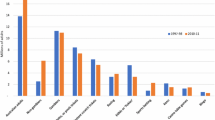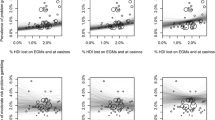Abstract
Although it is often assumed that electronic gaming machines (EGMs) are associated with the highest level of risk, it has proved difficult to find reliable evidence in support of this proposition. In this paper, we analysed statistics from major Australian community prevalence studies for the period 2011–2020 to investigate whether EGMs (in comparison to racing and casino table games) have a stronger association with problem gambling. All prevalence studies reviewed used telephone sampling and the Problem Gambling Severity Index to assess problem gambling. In this paper, we examine the principal hypothesis using several lines of evidence, including whether problem gamblers are more likely to gamble and gamble regularly on EGMs as opposed to racing and casino games and if the EGM-problem gambling association was maintained after controlling for other forms of participation. Results showed that of all gambling activities, EGMs do appear to have the strongest association with problem gambling. Despite having a disproportionately higher level of participation on racing and casino games as compared with other gamblers, problem gamblers are more likely to report regular or weekly participation in EGM gambling and this may be the reason why this activity emerges most strongly as a predictor of problem gambling in multivariate models. This finding is particularly salient, given the very high prevalence of EGM participation, compared to other risky gambling forms. The findings underscore the importance of survey reporting that presents results in a form that can inform policy relevant research relating to the potential impact of different gambling activities.
Similar content being viewed by others
Notes
Participation rates for EGM gambling were over 30% in the 1990s (Productivity Commission 1999) and racing was consistently around 20%.
References
Abbott, M., Bellringer, M., Garrett, N., & Mundy-McPherson, S. (2013). New Zealand gambling study wave 2. Report No. 4. Auckland: Gambling and Addictions Research Centre.
ACIL Allen Consulting. (2011). Second social and economic impact study of gambling in Tasmania. Hobart: Tasmanian Government Department of Treasury and Finance.
ACIL Allen Consulting. (2013). Third social and economic impact study of gambling in Tasmania. Hobart: Tasmanian Government Department of Treasury and Finance.
Baxter, A., Salmon, C., Dufresne, K., Carasco-Lee, A., & Mattesen, F. I. (2016). Gender differences in felt stigma and barriers to help-seeking for problem gambling. Addictive Behavior Reports,3, 1–8.
Blaszczynski, A., Derevensky, J., Goudrian, A., & Hodgins, D. (2013). Assessment tool to measure and evaluate the risk potential of gambling products, ASTERIG: A global validation. Gaming Law Review and Economics,17, 635–642.
Blaszczynski, A., Anjoul, F., Shannon, K., Keen, B., Pickering, D., & Wieczorek, M. (2015). Gambling harm minimisation report. Sydney: Office of Liquor, Gambling and Racing, NSW.
Browne, M., Rockloff, M., Hing, N., Russell, A., Murray-Boyle, C., & Rawat, V. (2019). NSW gambling survey, 2019. Sydney: NSW Responsible Gambling Fund.
Davidson, T., Rodgers, B., Taylor-Rogers, E., Suomi, A., & Lucas, N. (2015). 2014 survey on gambling, health and wellbeing in the ACT. Canberra: Centre for Gambling Research.
Dickerson, M., Hinchy, J., Legg-England, S., Fabre, J., & Cunningham, R. (1992). On the determinants of persistent gambling behaviour. I. High frequency poker machine players. British Journal of Psychology,83, 237–248.
Dixon, M. J., Stange, M., Larche, C., Graydon, C., Fuselsang, J., & Harrigan, K. (2017). Dark flow, depression and multiline slot machine play. Journal of Gambling Studies,33, 1–12.
Doran, B., & Young, M. (2010). Predicting the spatial distribution of gambling vulnerability: An application of gravity modeling using ABS Mesh Blocks. Applied Geography,30, 141–152.
Dowling, N., Smith, D., & Thomas, T. (2005). Electronic gaming machines: are they the ‘crack cocaine’ of gambling? Addiction,100, 33–45.
Dow-Schull, N. (2012). Addiction by design. Princeton: Princeton University Press.
Ferris, J., & Wynne, H. (2001). The Canadian problem gambling index final report. Phase II final report to the Canadian Interprovincial Task Force on Problem Gambling.
Gainsbury, S. (2012). Internet gambling: Current research findings and implications. New York: Springer.
Gannon, E., Delfabbro, P. H., & Sutherland, C. (2020). Gambling in rural and remote South Australia. International Journal of Mental Health and Addiction.
Griffiths, M. D. (1993). Fruit machine gambling: The importance of structural characteristics. Journal of Gambling Studies,9, 101–120.
Jackson, A. C., Thomas, S. A., Thomason, N., Crisp, B. R., Smith, S., Ho, W., et al. (1997). Analysis of clients presenting to problem gambling counselling services from July 1, 1996 to June 30, 1997, Client and services analysis report No. 2. Melbourne: Victorian Department of Human Services.
Jackson, A. C., Thomas, S. A., Thomason, N., Borrell, J., Crisp, B. R., Ho, W., et al. (1999). Demographic profile, gambling activity and service use of clients presenting to Break Even problem gambling counselling services, July 1, 1995–June 30, 1997, Client and services analysis report, No. 3. Melbourne: Victorian Department of Human Services.
Jackson, A. C., Wynne, H., Dowling, N. A., Tomnay, J. E., & Thomas, S. A. (2010). Using the CPGI to determine problem gambling prevalence in Australia: Measurement issues. International Journal of Mental Health and Addiction,8, 570–582.
Livingstone, C., Woolley, R., Zazryn, T., Bakacs, L., & Shami, R. (2008). The relevance and role of gaming machine games and game features on the play of problem gamblers. Adelaide: Independent Gambling Authority.
McCormick, J., Delfabbro, P., & Denson, L. (2012). Psychological vulnerability and problem gambling: An application of Durand Jacobs' general theory of addictions to electronic gaming machine playing in Australia. Journal of Gambling Studies,28, 665–690.
Ministry of Health. (2005). Problem gambling intervention services in New Zealand: 2004 national statistics. Wellington: Ministry of Health.
Ministry of Health. (2006). Problem gambling intervention services in New Zealand: 2005 service-user statistics. Wellington: Ministry of Health.
Ministry of Health. (2007). Problem gambling intervention services in New Zealand: 2006 service-user statistics. Wellington: Ministry of Health.
Parke, J., Parke, A., & Blaszczynski, A. (2016). Key issues in produced-based harm minimisation. London: The Responsible Gambling Trust.
Paton-Simpson, G. R., Gruys, M. A., & Hannifin, J. B. (2001). Problem gambling counselling in New Zealand: 2001 national statistics. In Report prepared for the Problem Gambling Committee. Wellington: Department of Internal Affairs.
Productivity Commission. (1999). Australia’s gambling industries. Canberra.
Productivity Commission. (2010). Gambling. Inquiry report. Canberra.
Treasury, Q. (2019). Australian gambling statistics. Brisbane: Queensland Government.
Rockloff, M., Thorne, H., Goodwin, B., Moskovsky, N., Langham, E., Browne, M., et al. (2015). EGM environments that contribute to excess consumption and harm. Melbourne: Victorian Responsible Gambling Foundation.
Rockloff, M., Browne, M., Hing, N., Thorne, H., Russell, A., Greer, N., et al. (2019). Victorian population gambling and health survey (2018–2019). Melbourne: Victorian Government.
Schottler Consulting. (2015). Study of gambling and health in Victoria. In Findings from the Victorian Prevalence Study 2014. Melbourne: VRGF.
Sproston, K., Hing, N., & Palankay, C. (2012). Prevalence of gambling and problem gambling in New South Wales. Sydney: NSW Office of Liquor, Gaming and Racing.
Woods, K., Sproston, K., Brook, K., Delfabbro, P., & O’Neil, M. (2018). Gambling prevalence in South Australia. Adelaide: Department of Human Services.
Ziolkowski, S. (2016). The world count of gaming machines. Sydney: Gambling Technologies Association.
Author information
Authors and Affiliations
Corresponding author
Additional information
Publisher's Note
Springer Nature remains neutral with regard to jurisdictional claims in published maps and institutional affiliations.
Rights and permissions
About this article
Cite this article
Delfabbro, P., King, D.L., Browne, M. et al. Do EGMs have a Stronger Association with Problem Gambling than Racing and Casino Table Games? Evidence from a Decade of Australian Prevalence Studies. J Gambl Stud 36, 499–511 (2020). https://doi.org/10.1007/s10899-020-09950-5
Published:
Issue Date:
DOI: https://doi.org/10.1007/s10899-020-09950-5




